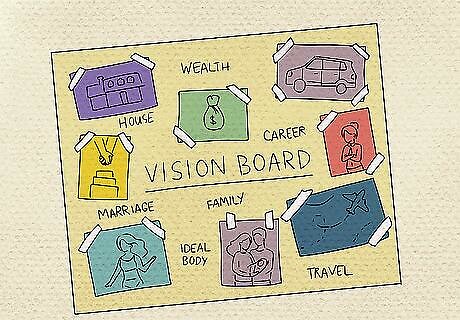
views
Defining Your Dream

Start by asking yourself what makes you happy. Brainstorm all the things you can think of that make you feel enthusiastic, excited, and happy in the past. Create a list, and don’t let yourself feel limited by your daily circumstances or what you feel is realistic or possible for you. Right now you are trying to figure out what you want, not what you should be doing. Banish your negative thoughts and focus on the positive to create this list. Use this list to help you define a dream that will be a positive place to work toward. Your list should include activities that you truly enjoy. For example, maybe you feel happiest surfing, reading books, writing poetry, swimming, or spending time with your neighbor's dog.

Create a personal mission statement. Mission statements aren’t just for big corporations. A personal mission statement provides purpose and direction to action – and that’s something that is important for individuals, too. A mission statement explains what’s important to you and where you want to go in the future. To create one, reflect on your core values (attributes that matter to you and speak to your priorities in life), your past successes, the contributions you want to make to the world, and your short- and long-term goals. Use all four of these to create a one-sentence statement of your mission in life. An example mission statement for a new career path might read: "I value being part of making the world a kinder, gentler world for animals, and I will build on my commitment to these values by working toward a world where all animals are healthy and happy." Post your mission statement somewhere you will see it every day. Seeing your mission statement often will help to keep you on track as you are working hard to achieve your dream. Revisit your mission statement periodically. Things change, and you might want to redefine your mission statement – in small ways or more radical ways – as time goes on.

Re-examine your past goals. Have you worked toward a dream goal in the past and failed or gotten stalled? Take the time to reflect on your past experience. What got in the way of your success? What worked well? Try to let feelings of guilt, shame, or regret go – you are entering a new chapter of your life and it is important to examine your past experiences so that you don’t repeat them. But it is also important to reflect on what your strengths have been in the past so that you can make them work for you in the future.

Create a vision board. One way to help understand your dream is to create a vision board. To make a vision board, you will need a large piece of poster paper, glue, and a bunch of paper and/or magazines. Create a collage on your poster paper that represents the images and words that are your highest priorities in life. Don’t worry if some of your vision items are frivolous – maybe you really do want to own a beach house one day. Choose words and images that appeal to you.

Consider what you can and can’t control. You can’t control the actions of others that might get in the way of your dream. And you can’t control the universe as a whole. Try to define some of the things about achieving your dream that might be unpredictable, using your experiences from the past.

Reflect and then write out your dream as a manageable goal. Take a look at everything you have done – your happiness list, mission statement, learnings from the past, and vision board. Now begin to craft a simple and clear goal from these materials. Try to define your dream in simple terms, using just one sentence. For example, a clear one-sentence goal might be: “I will save more of my income each month so that I can go backpacking through Mexico next summer.”
Accomplishing Your Dream

Break your dream goal down into parts. Achieving your dream might require you to gain new skills or knowledge. Be sure that you don’t define your dream so narrowly that you get "tunnel vision" and ignore the things you need to learn in order to make your dream a reality. Create one or more "learning goals" – learning new skills or new information. Achieving your learning goals can be a crucial step to working toward your dream. For example, If your ultimate goal is to buy a beach house, then you might need to learn about the real estate market in seaside areas near you as well as learn more about how to invest money so that you can save more quickly for a down payment on your beach house.

Find out how others have accomplished your goal. Do some research to find out how other people have achieved the same dream. You can try using the internet to look for articles or biographies of people you admire who have achieved their dream. You might even want to talk with people in real life. For example, if your dream is to become an architect, try to speak with someone at an architecture school. If you don’t live nearby and can’t meet them in person, try to talk with someone on the phone.

Break your dream down into manageable "projects". Achieving a dream can be complicated and you might need to complete a number of different "projects" as you go forward. Figure out what the different "projects" are that will move you toward your dream. Remember that you need to have all the ingredients and tools you need in order to be successful in achieving your dream. If your dream is to become a black belt in karate or play the piano, then you might need to start by saving money for lessons, finding an excellent teacher, and finding the uniform or instrument you need.

Define the steps for each "project." Create a plan for each of the projects by defining all of the steps you will need to follow in order to complete the project. Write down all the steps in order, and keep your project task lists somewhere convenient. For example, if your project involves buying something big, figure out how much money you will need to save. Similarly, if you are interested in learning a new skill that requires a teacher, ask friends (or the internet) about good teachers in your area and what kind of equipment you will need for the new activity.

Commit to your dream by taking action on each "project." Start taking action on each part of your dream. If you can, work on all of your projects simultaneously – for example, try to do something for each project each week. Even if you are moving in small steps toward your goal, you are still heading in the right direction. And keeping yourself moving forward is one of the best ways to stay motivated toward achieving your goal. Going for your dream means taking action on many small steps over a long period of time. If you can only spend 15 minutes one week on your dream, remember that the most important thing is to keep moving forward down your "to do" list of project tasks.

Always know what’s next on your list. As you are taking action on the different projects that lead you to your dream, be sure that you always know what to do next. Being unsure of your next step is one common way that people get stalled in their progress toward a goal. So each week revisit your project lists to see what tasks are coming up and be sure that you will be ready for each one.

Manage your time so that there is room for your dream. Working toward your dream sometimes needs to be done in the midst of a life where you have lots of other things to do – taking care of children or working late, for example. In order to achieve your dream, you need to make sure you carve out the time that is necessary to move forward on your goals. Try to create time in your week that is purposefully devoted to your dream, and make that time a priority. If you are a very busy person, finding time to act on a long-term goal can be challenging. If you are too tired when you are finished with everything else for the day, then try working on your dream in the morning before you get busy with other activities. Set up an actual schedule to keep yourself on track, even if the time you spend working on your goal each day is small. Being consistent is what's important.

Use your missteps as a lesson. Learn from your mistakes and keep on going. Achieving a dream takes persistence. Know that you will encounter obstacles and failures. Use these as opportunities to learn. What can you do differently from now on? Get yourself back on track and keep moving forward.

Be inspired by others. Seek out the people who have achieved their dreams and talk with them or read their stories. Find out what they learned from their journey, and what they like best about achieving their dream. You can find out about other successful dreamers by reading their biographies, watching documentary films, or reading about people on the Internet.




















Comments
0 comment